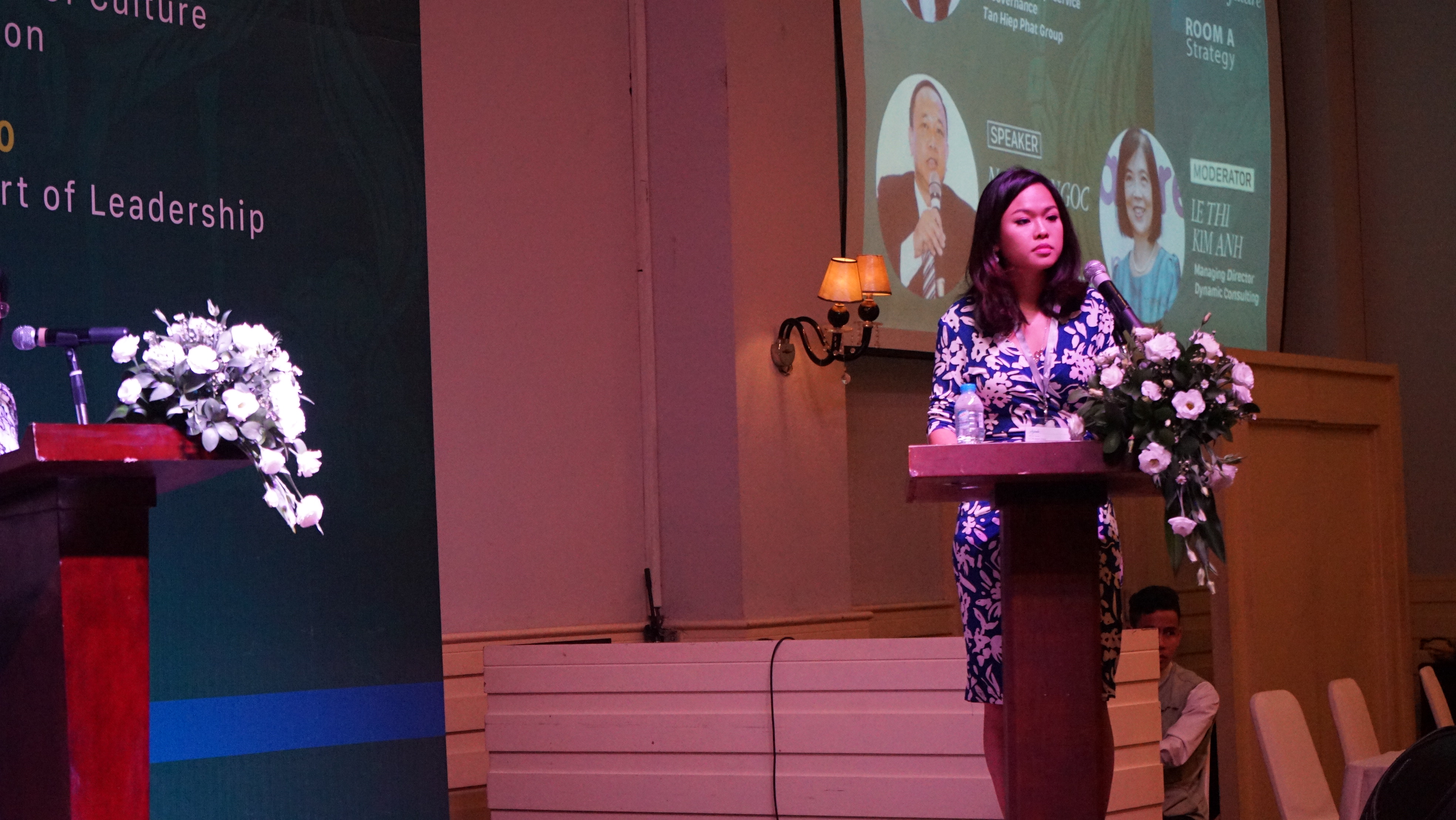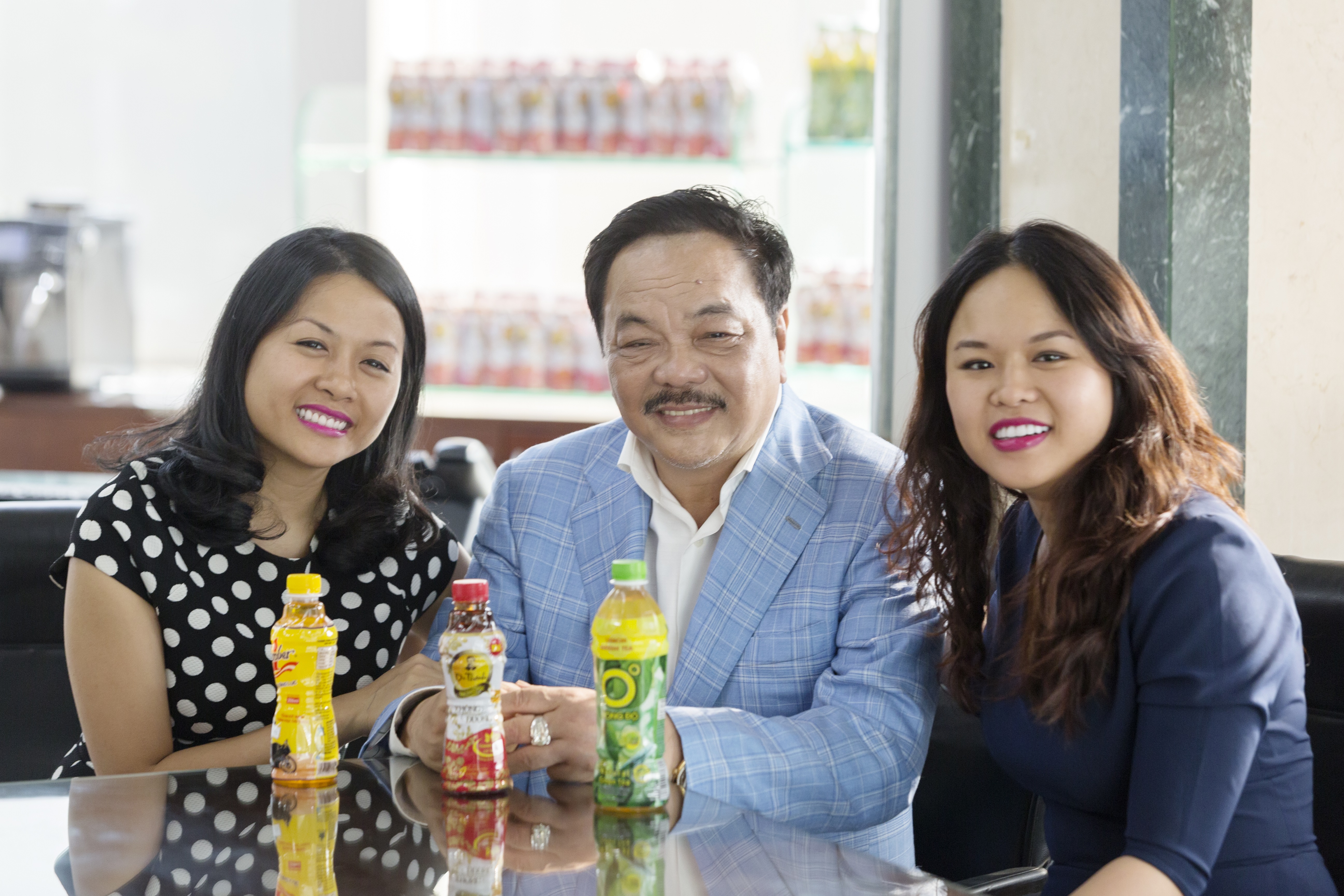Human resources management: core mindset of a billion-dollar enterprise
 |
| Tran Ngoc Bich talking at Human Resources Management Conference 2017 |
As one of the main speakers at Human Resources Management Conference 2017, which took place on September 14 in Ho Chi Minh City, Tran Ngoc Bich, HR manager of Tan Hiep Phat, talked with VIR’s Tuong Vi about her experiences of implementing Tan Hiep Phat’s HR management mindset.
Tan Hiep Phat’s long-lasting survival
Bich said that in 2009, 13 years after reaching the number one position in the Vietnamese beverage market, the company founder Tran Qui Thanh raised a question. It is not difficult for Tan Hiep Phat to achieve a certain growth rate, but how can the group develop sustainably on the long-term, especially after he leaves the group? This question was the start of Bich’s story about Tan Hiep Phat’s journey.
With warmth and confidence at slight odds with the youthful appearance of a 30-year-old woman, Bich said that she had realised that there were two core factors leading to the group’s sustainable survival. The first one is ‘infecting’ the other leaders of the group with the ambition and mindset of the founder. The second factor is about leveraging the skills of every leader of the group to maintain the operating culture the founder had created.
Tan Hiep Phat has nearly 10,000 workers, so the company's general director cannot know them all by name. According to Bich, what connects the whole enterprise is culture. With these two core principles, HR management in Tan Hiep Phat has been constantly moving forward.
 |
| Founder Tran Qui Thanh and his two daughters |
The founder of Tan Hiep Phat, Tran Qui Thanh, said that one of his strategies that helped the company flourish was to let employees manage themselves. As one of Thanh’s supporters and heiresses to his efforts in the group’s HR management, can you talk about how this strategy worked out?
In Tan Hiep Phat, we believe that every individual adds special value to the enterprise. Thus, what we have to do is to provide favourable conditions for them to contribute and demonstrate their abilities. Our principles are few and will be even fewer, but we have high standards. One of these is that every individual needs to be devoted to the sustainable growth of Tan Hiep Phat. We are unified as one community and we are responsible for things that are bigger than each of us.
We pay special attention to the enterprise’s culture because HR management is a key factor in change management, and other resources are also under the management of the HR department. We believe that if employees understand the enterprise’s culture and can bring out their best through it, the sustainable development of the enterprise will be a matter of time only.
What exactly does “letting employees manage themselves” mean?
 |
Tan Hiep Phat promotes self-management and self-control among employees. You have knowledge and skills, Tan Hiep Phat needs to develop and has the capital and a favourable environment for you to apply your knowledge and skills. The group provides employees with precious resources, such as capital, information and technology systems, and customers, with the expectation that every employee will manage the assigned resources and treat them as their own.
I inherited this mindset from my father, the founder of Tan Hiep Phat. He wanted to build a group where employees are treated like a “companion on a big journey,” not like “a hired employee working for Tan Hiep Phat.”
Employees in Tan Hiep Phat will receive a salary in direct proportion with their productivity, which they can spend purchasing company shares, giving them actual ownership in the group and receive profit after positive performance.
Since establishment, the number of employees in Tan Hiep Phat has been sharply increasing over the year, and for us, their long-term connection and dedication to the group brings great happiness. Hundreds of employees have devoted their lives to Tan Hiep Phat since its establishment 23 years ago.
Qualifications are obviously a necessary condition, but what other qualities is Tan Hiep Phat looking for in job applicants?
Employees have to get on well with their colleagues, including adopting the group’s culture and teamwork skills. The value of each employee is in his or her ability to contribute to the group’s collective capacity. In today’s innovative and fast-moving world, creativity is precious, but it can be transferred from experts or professional consultants. Thus, we regard highly the ability of fitting into the group’s workforce upon entering the group.
We have learnt a lesson when we decided to build a new plant a few years ago. As the investment was huge and we set a high target of a sizeable plant with global standards, we invited a director who had been involved in building the biggest beverage plant in the world to be the project manager. After six months of implementation, this director failed to create his own team for the project, so we had to choose someone else.
 |
| Promoting autonomy and resourcefulness down to the lowest levels is Tan Hiep Phat Group's HR credo |
In the world of Industry 4.0, of rapidly changing human-human and human-machine interactions, what are the strengths and weaknesses of billion-dollar enterprises like Tan Hiep Phat?
In Industry 4.0, working opportunities are increasing and opening up for everyone. However, as we always say, we appreciate individual capabilities. If you work in Tan Hiep Phat for a long time and you can demonstrate a ready-to-do attitude, willingness to learn and take on responsibilities, we will offer you more responsibilities and more autonomy, along with higher salary.
However, if you decide to leave Tan Hiep Phat, we will wish you all the best. Do not be afraid of change. You should contribute your full knowledge and wisdom to your next employers. And one day, maybe we will benefit each other with a potential cooperation. Besides, we still welcome our old employees back, whenever they come a-knocking.
You have had plenty of chances to study HR management skills in developing countries during your studies abroad and real-life experience as well. Can you talk about the leadership models you have encountered?
In the world, there are two leadership models. The first one was the model of command-and-control and it is so popular that it is virtually equivalent to “management,” and it really is management, not leadership.
This model emphasises the power of leaders by imposing a wide range of regulations and punishments on employees who understand that they are working under strict terms and conditions. However, this style limits employees’ performance.
I believe that in the knowledge economy, success derives directly from innovation, not from strict regulations. In other words, success does not originate from a perfect reproduction of old practices; it must be based on the expansion of knowledge and innovation. The best environment for knowledge improvement is an enterprise with a distinctive culture where employees are encouraged to innovate for both their and the enterprise’s benefit.
We are attempting to create a new model to replace command-and-control management, which is we call “Participative leadership model” at the moment. We want to maintain a leadership style where leaders take responsibility first when goes awry. In most cases, problems derive from leaders, so they should focus on solving matters, not looking for a scapegoat. In addition, leaders’ solutions that benefit only Tan Hiep Phat or leaders themselves will not be accepted, as we lay heavy emphasis on creating sustainable value for community development.
| Tan Hiep Phat’s great aspiration to become a billion-dollar Vietnamese enterprise Starting off as a small family-run business, by developing an exceptional operational system in accordance with international management standards and practices, Tan Hiep Phat Group has made leaps and bounds towards its aspiration to reach out to Asia and gradually position itself as a Vietnamese enterprise that is worth billions of dollars. Tran Uyen Phuong, deputy general director of the group, said that it would be difficult for someone to change the world on their own, but with the proper team for company, nothing is impossible. Tan Hiep Phat welcomes those who share the same mindset and wishes to build a team to shore up support for its vision. |
| Water efficiency and community development: Tan Hiep Phat’s recipe for success Tran Uyen Phuong, deputy general director of Tan Hiep Phat Group, Vietnam’s largest beverage company, shares with VIR’s Kim Duc the core values behind the company’s growth and its corporate social responsibility record, particularly the smart usage of water resources in production, looking for sustainable development. |
What the stars mean:
★ Poor ★ ★ Promising ★★★ Good ★★★★ Very good ★★★★★ Exceptional
Latest News
More News
- Ho Chi Minh City hits $8.37 billion in FDI (December 29, 2025 | 08:28)
- Tax sector wraps up 2025 and sets priorities for next year (December 25, 2025 | 14:00)
- Heavy industries set for pilot greenhouse gas quotas (December 25, 2025 | 10:00)
- $250 million deal targets women-owned SMEs, sustainable agriculture (December 22, 2025 | 17:40)
- UOB sees Vietnam growth easing in fourth quarter (December 22, 2025 | 17:39)
- Government moves to establish International Financial Centre (December 21, 2025 | 21:00)
- Vietnam's IFC to target global investment flows (December 21, 2025 | 18:00)
- Ha Tinh breaks ground on major Vingroup industrial and energy projects (December 19, 2025 | 18:24)
- EVN launches major power infrastructure projects nationwide (December 19, 2025 | 18:17)
- VAL inaugurates second production line to meet domestic animal feed demand (December 19, 2025 | 16:37)



















 Mobile Version
Mobile Version